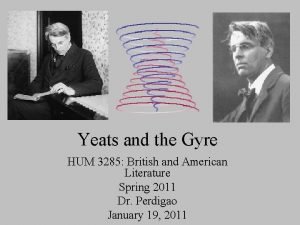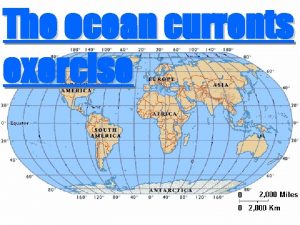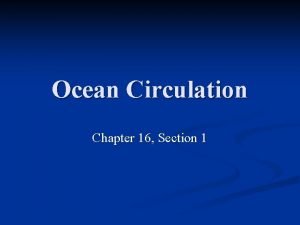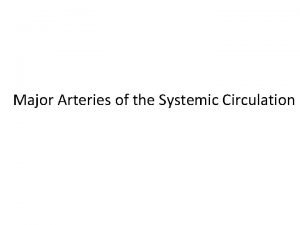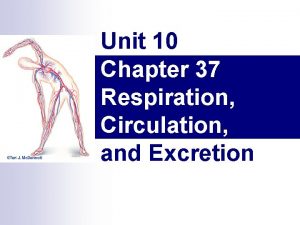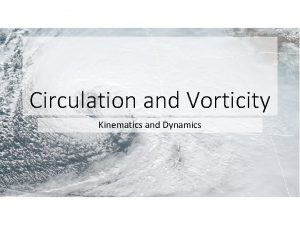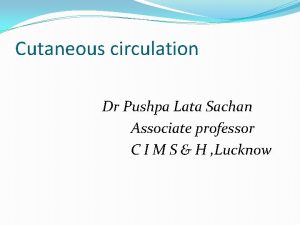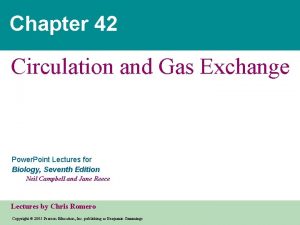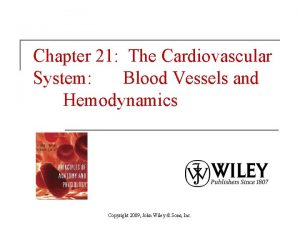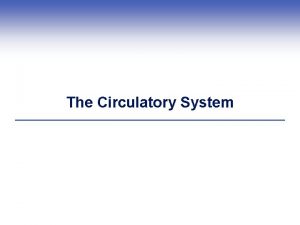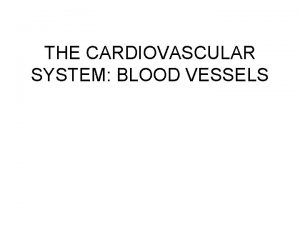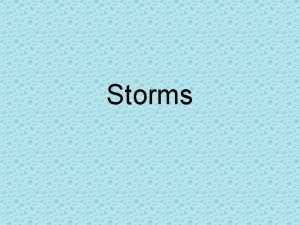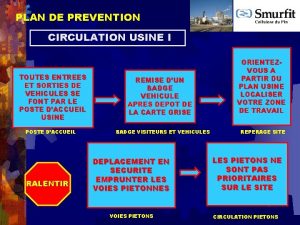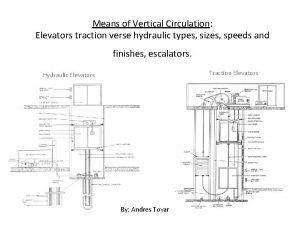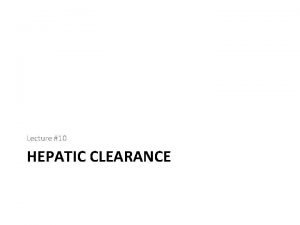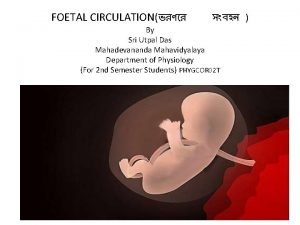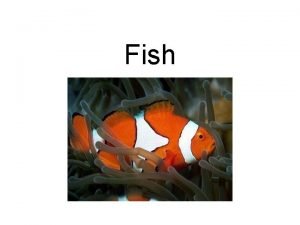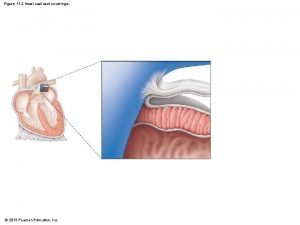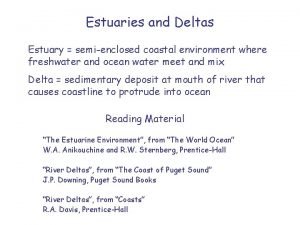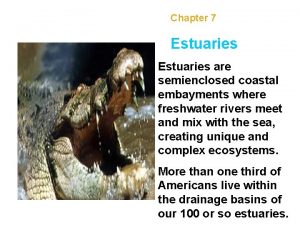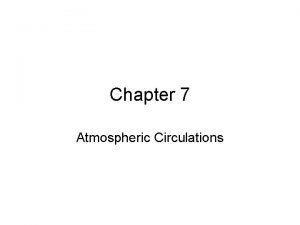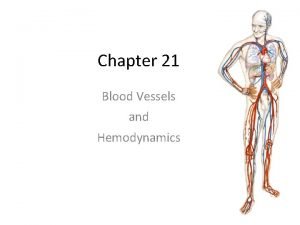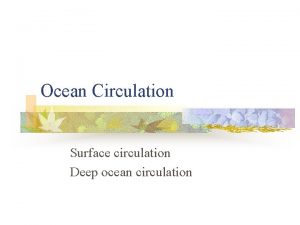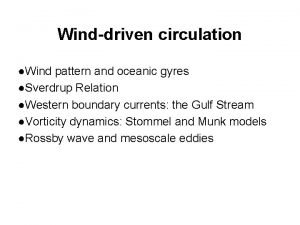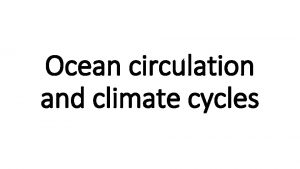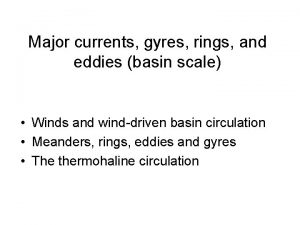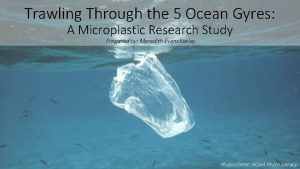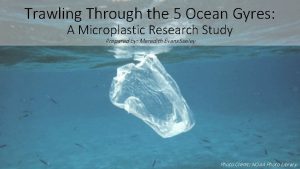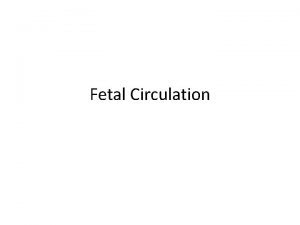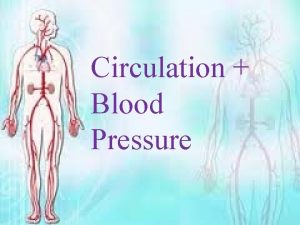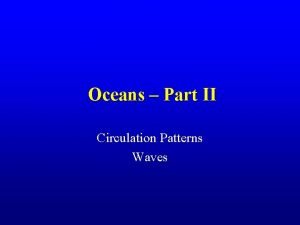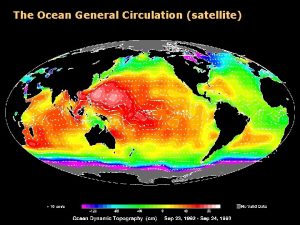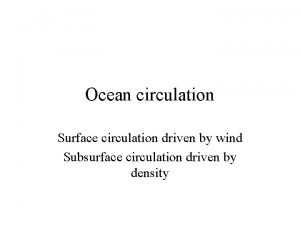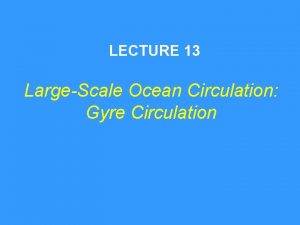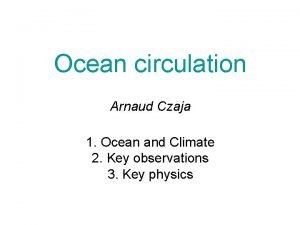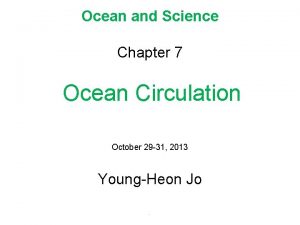Ocean Circulation and Structure Major ocean circulation Gyres

















































- Slides: 49

Ocean Circulation and Structure

Major ocean circulation Gyres: clockwise in Northern Hemisphere and counter clockwise in southern hemisphere Fig. 10 -14, p. 271

Gyres

Know the currents in the red boxes from slide 2. Table 10 -1, p. 271

Florida Current

EOS (American Geophysical Union) Volume 92 number 3 18 JANUARY 2011 pages 21– 28

EOS (American Geophysical Union) Volume 92 number 3 18 JANUARY 2011 pages 21– 28





Upwelling of cold nutrient rich water Fig. 10 -16, p. 273


Upwelling of cold nutrient rich water is a result of the Ekman Spiral. The prevailing winds, frictional drag, and the coriolis force all work together to given an average surface transport of ocean waters in a direction 90 degrees to the right in NH (left for SH) from surface winds Fig. 10 -17, p. 273

Upwelling bring cool nutrient rich waters to the surface. Fig. 10 -18, p. 274

Gulf stream is a western boundary current western Fig. 10 -15, p. 272

The Gulf stream is considered to be a western boundary current. It is relatively narrow and fast. (it is found on the western boundary of the Atlantic ocean) The California current is considered to be a eastern boundary current. It is relatively wide and slow moving. (it is found on the eastern boundary of the Pacific ocean)

Major ocean circulation Gyres: clockwise in Northern Hemisphere and counter clockwise in southern hemisphere Fig. 10 -14, p. 271

Why western boundary currents are fast and tight.

Vertical Structure Know what the surface zone and thermocline are.

CTD instrument Conductivity, Temperature, Depth Each time one goes down 10 meters in the ocean the pressure increases by 1 Atmosphere (1 Bar). 1. 0 decibars=1. 0 meter

Circle the best choices. Temperature normally (increases/ decreases) with depth. Salinity normally (increases/ decreases) with depth. Density normally (increases/ decreases) with depth.

Circle the best choices. Temperature normally (increases/ decreases) with depth. Salinity normally (increases/ decreases) with depth. Density normally (increases/ decreases) with depth.

Be familiar with these terms and there order from the surface down


Many of the world's largest ocean trenches are located along the "Ring of Fire, " an arc of volcanoes around the Pacific Ocean that denotes convergent plates margins (Fig. 3).

Thermal Haline Circulation Ocean downwelling driven by cold salty water of North Atlantic

Ocean temperature and salinity combine to determine the density of sea water. Cold salty water is very dense and sinks. Salinity is controlled by the difference between evaporation and precipitation as well as fresh water discharge from rivers and glacial melt.

Ocean salinity is typically around 35 parts per thousand 35 %0 and made up primarily of sodium chloride (table salt). Salt composition is 85 % sodium chloride.

Temperature isotherms (degree C) in western Atlantic. What is the approximate temperature at the equator and a depth of 1000 m (1 km)?

Temperature isotherms (degree C) in western Atlantic. What is the approximate temperature at the equator and a depth of 1000 m (1 km)? About 4. 7 o. C

Temperature isotherms (degree C) in Central Pacific. What is the approximate surface temperature at the equator?

Temperature isotherms (degree C) in Central Pacific. What is the approximate surface temperature at the equator? 25 o C


The mediterranean outflow contributes significantly to the salinity of the Atlantic. The mediterranean has become saltier in recent times as more of the fresh water feeding it is used up before reaching the mediterranean.

Western Atlantic is generally much saltier than central Pacific. What is the approximate maximum salinity o/oo shown in the above data display? Assume that all isopleths of constant salinity are 0. 2 o/oo apart.

Western Atlantic is generally much saltier than central Pacific. What is the approximate maximum salinity o/oo shown in the above data display? Assume that all isopleths of constant salinity are 0. 2 o/oo apart. About 35. 0 part per thousand.


What is the polarity of each connection? Evaporation ---------------- +/- surface salinity Precipitation --------------- +/- surface salinity Surface salinity ------------ +/- evaporation Evaporation --------------- +/- precipitation

What is the polarity of each connection? Evaporation ---------------- +/- surface salinity Precipitation --------------- +/- surface salinity Surface salinity ------------ +/- evaporation Evaporation --------------- +/- precipitation

Positive feedback for ocean salinity What are the polarities of the connection in the above causal loop diagram? Does this describe a positive or negative feedback loop?

Positive feedback for ocean salinity Be able to explain in words this positive feedback process Or Be able to take a verbal description and draw the causal loop Diagram above.


NADW North Atlantic Deep water AABW Antarctic Bottom Water

Ocean temperature and salinity combine to determine the density of sea water. Cold salty water is very dense and sinks. Salinity is controlled by the difference between evaporation and precipitation as well as fresh water discharge from rivers and glacial melt.

Near Bottom D 14 C %o Larger differences between surface water and deep water suggest “older” water. These water age estimates suggest that the north Atlantic is the primary driver of the global oceanic conveyor belt.

If one started with 1000 counts per minute (cpm) from a radioactive sample, how many cpm would one expect after 4 lifetimes?

If one started with 1000 counts per minute (cpm) from a radioactive sample, how many cpm would one expect after 4 lifetimes? 1000/24=1000/16=62. 5 cpm

Change in the position of continents over the past 200 million years (or more) has influenced global oceanic circulation and global climate.
 Yeats gyre
Yeats gyre The darkness drops again but now i know
The darkness drops again but now i know Surface gyres
Surface gyres Surface gyres
Surface gyres Single vs double circulatory system
Single vs double circulatory system Single circulation and double circulation
Single circulation and double circulation Bronchiole
Bronchiole Slowing atlantic ocean circulation
Slowing atlantic ocean circulation Major arteries of the systemic circulation
Major arteries of the systemic circulation Chapter 15 ocean water and ocean life wordwise answer key
Chapter 15 ocean water and ocean life wordwise answer key Convergent boundary features
Convergent boundary features Ocean ocean convergent boundary
Ocean ocean convergent boundary Convergent boundary
Convergent boundary Ocean ocean convergent boundary
Ocean ocean convergent boundary Convergent boundary
Convergent boundary Ocean to ocean convergent boundary
Ocean to ocean convergent boundary Red ocean vs blue ocean
Red ocean vs blue ocean Chapter 37 respiration circulation and excretion
Chapter 37 respiration circulation and excretion Kelvin circulation theorem
Kelvin circulation theorem Chapter 14 circulation and blood vessels
Chapter 14 circulation and blood vessels Triple response and cutaneous circulation
Triple response and cutaneous circulation Micro and macro circulation
Micro and macro circulation Chapter 42 circulation and gas exchange
Chapter 42 circulation and gas exchange Chapter 21 blood vessels and circulation
Chapter 21 blood vessels and circulation Bat characteristics
Bat characteristics Major histocompatibility complex structure
Major histocompatibility complex structure Class mhc
Class mhc Two circulation syndrome
Two circulation syndrome Single loop blood circulation
Single loop blood circulation Pulmonary circulation pathway
Pulmonary circulation pathway Circulation of air masses
Circulation of air masses Hepatic portal system
Hepatic portal system Plan de circulation usine
Plan de circulation usine Echidna digestive system
Echidna digestive system Illegal alien definition ap human geography
Illegal alien definition ap human geography Hydraulic fracturing disadvantages
Hydraulic fracturing disadvantages Blood circulation in liver
Blood circulation in liver Circulation extracorporelle
Circulation extracorporelle Components of bile
Components of bile Flow chart of fetal circulation
Flow chart of fetal circulation Are fish in the kingdom animalia
Are fish in the kingdom animalia Figure 11-2 is an anterior view of the heart
Figure 11-2 is an anterior view of the heart Estuary circulation
Estuary circulation Estuary circulation
Estuary circulation Single cell model of atmospheric circulation
Single cell model of atmospheric circulation Components of the bile
Components of the bile Chapter 34 circulation in humans concept mapping answer key
Chapter 34 circulation in humans concept mapping answer key Chapter 21 hemodynamics
Chapter 21 hemodynamics Figure 11-8 arteries
Figure 11-8 arteries Figure 11-14 is a diagram of a capillary bed
Figure 11-14 is a diagram of a capillary bed
